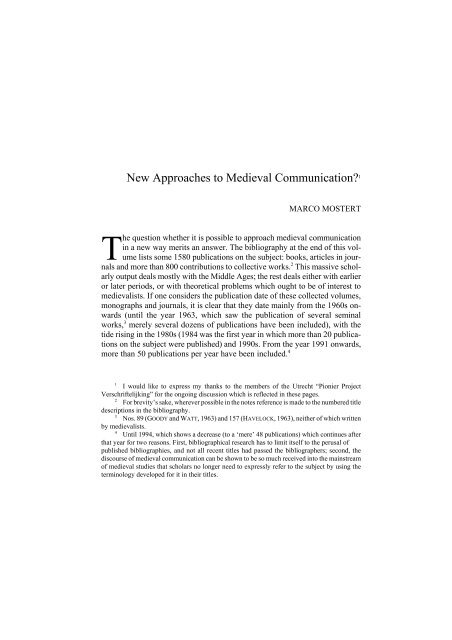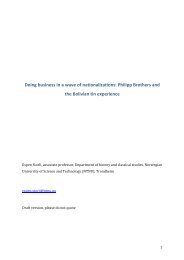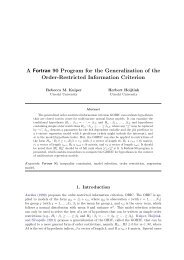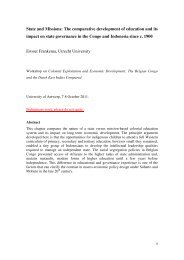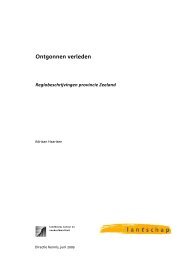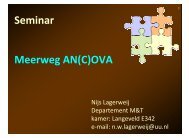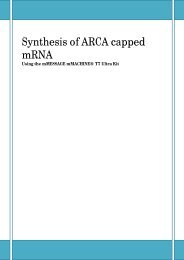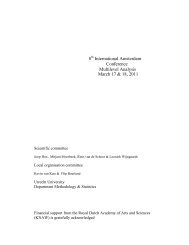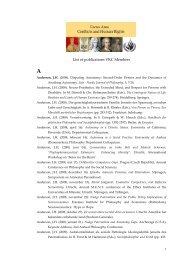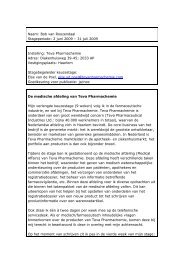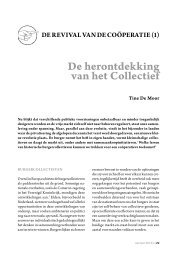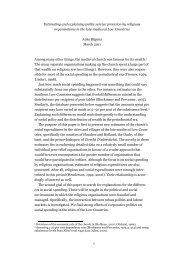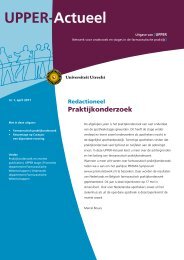New Approaches to Medieval Communication?1
New Approaches to Medieval Communication?1
New Approaches to Medieval Communication?1
You also want an ePaper? Increase the reach of your titles
YUMPU automatically turns print PDFs into web optimized ePapers that Google loves.
<strong>New</strong> <strong>Approaches</strong> <strong>to</strong> <strong>Medieval</strong> <strong>Communication</strong>? 1MARCO MOSTERTThe question whether it is possible <strong>to</strong> approach medieval communicationin a new way merits an answer. The bibliography at the end of this volumelists some 1580 publications on the subject: books, articles in journalsand more than 800 contributions <strong>to</strong> collective works. 2 This massive scholarlyoutput deals mostly with the Middle Ages; the rest deals either with earlieror later periods, or with theoretical problems which ought <strong>to</strong> be of interest <strong>to</strong>medievalists. If one considers the publication date of these collected volumes,monographs and journals, it is clear that they date mainly from the 1960s onwards(until the year 1963, which saw the publication of several seminalworks, 3 merely several dozens of publications have been included), with thetide rising in the 1980s (1984 was the first year in which more than 20 publicationson the subject were published) and 1990s. From the year 1991 onwards,more than 50 publications per year have been included. 41I would like <strong>to</strong> express my thanks <strong>to</strong> the members of the Utrecht “Pionier ProjectVerschriftelijking” for the ongoing discussion which is reflected in these pages.2For brevity’s sake, wherever possible in the notes reference is made <strong>to</strong> the numbered titledescriptions in the bibliography.3Nos. 89 (GOODY and WATT, 1963) and 157 (HAVELOCK, 1963), neither of which writtenby medievalists.4Until 1994, which shows a decrease (<strong>to</strong> a ‘mere’ 48 publications) which continues afterthat year for two reasons. First, bibliographical research has <strong>to</strong> limit itself <strong>to</strong> the perusal ofpublished bibliographies, and not all recent titles had passed the bibliographers; second, thediscourse of medieval communication can be shown <strong>to</strong> be so much received in<strong>to</strong> the mainstreamof medieval studies that scholars no longer need <strong>to</strong> expressly refer <strong>to</strong> the subject by using theterminology developed for it in their titles.
16 MARCO MOSTERTThe contribu<strong>to</strong>rs <strong>to</strong> this volume do not claim <strong>to</strong> have themselves developedhighly original approaches <strong>to</strong> medieval communication. Their approaches arenot ‘new’ in this sense. Rather, they address questions which have been raisedfairly recently in medieval studies about communication, literacy and orality,in the hope that their provisional answers might show others ways in which <strong>to</strong>arrive at some cogent answers.The question might be put whether medieval communication is in itself avalid subject for research. The implicit answer given by the very existence ofthis volume is affirmative. In order <strong>to</strong> substantiate it, a his<strong>to</strong>riographical reviewof some of the evidence accumulated in the bibliography can be given. Manysurveys of the debate on medieval literacy exist; 5 <strong>to</strong> my knowledge, no surveyof that debate in the context of medieval communication has as yet been attempted.<strong>Communication</strong> as it is unders<strong>to</strong>od in this volume is a modern concept. Wehave <strong>to</strong> be clear about what it means in medieval studies before we can studymedieval communication. On the basis of the literature on the subject, we mayattempt <strong>to</strong> establish which forms and modes of communication were available<strong>to</strong> medieval men and women. Because written and oral modes have so far beenat the centre of attention, we will pay attention <strong>to</strong> the words denoting the conceptsof literacy and orality. As Anglo-Saxon and German scholarly traditionshave been the most influential in this domain, we will limit ourselves <strong>to</strong> theterminology developed in those two languages. Once we are clear about whatwe mean when we talk about medieval communication, we may survey thecontents of the publications on the subject. Finally, we may suggest somepromising ‘new’ approaches <strong>to</strong> medieval communication.<strong>Communication</strong> and the Study of the Middle Ages‘<strong>Communication</strong>’ and its German equivalent ‘Kommunikation’ are relativelylate arrivals in medieval studies. ‘<strong>Communication</strong>’ first makes its appearancein 1979, as part of the title of Michael Richter’s book on oral communicationin England in the later Middle Ages. 6 The word tends <strong>to</strong> be used initiallyfor forms of non-written communication, be they oral 7 or non-verbal. 8 It5Nos. 31-74.6No. 300.7Nos. 1248 (ASSMANN, 1980), 560 (VAN UYTFANGHE, 1984), 518 (KLEINSCHMIDT, 1988),510 (BANNIARD, 1992) and 525 (RAIBLE, 1994).8Nos. 410 (MCCLINTOCK, 1981) and 1543 (NEWBOLD, 1997).
<strong>New</strong> <strong>Approaches</strong> <strong>to</strong> <strong>Medieval</strong> <strong>Communication</strong>?17may be used in studies of daily life, 9 more in particular of that of villagers. 10 Itis only very recently that the word is used for forms of communication practisedby powerful laymen who are also able actively <strong>to</strong> use the written word.Gerd Althoff’s use of ‘Kommunikation’ in his studies of ‘political’ and ‘symbolic’communication, which have been published from 1993 onwards, 11 havemade an impact in Münster. 12 Rather than on the rulers’ and subjects’ ability<strong>to</strong> read, write, and understand the assumptions of written communication, theemphasis in his work is on the oral and non-verbal aspects of ritual. ‘<strong>Communication</strong>’denotes a <strong>to</strong>pic different from that of writing and its uses. When oraland written modes of communication are compared, as in the case of EarlyIrish Literature – Media and <strong>Communication</strong>, an early volume in the Freiburgseries ScriptOralia, published in 1989, the word ‘communication’ seem <strong>to</strong>spring <strong>to</strong> mind because of the explicit reference <strong>to</strong> non-written communication.13 There are as yet no attempts <strong>to</strong> use the word ‘communication’ as a neutralterm <strong>to</strong> denote the study of the whole set of forms of communication available<strong>to</strong> medieval man, <strong>to</strong>gether with the psychological and social implicationsof their use. <strong>Medieval</strong> his<strong>to</strong>ry does not as yet seem <strong>to</strong> have grasped the importanceof the insights of sociologists of literature, who correctly see writing asmerely one of the forms of communication which may or may not be availablein any given society. 14 Or if medievalists have read their studies, they hardlyever refer <strong>to</strong> them.Because of the paucity of publications dealing explicitly with medievalcommunication, there have been very few attempts <strong>to</strong> describe what the term‘medieval communication’ may stand for. Apparently, medievalists are content<strong>to</strong> leave discussion of the concept <strong>to</strong> other disciplines. When they are merelydealing with an aspect of communication, they may be excused for assumingits meaning <strong>to</strong> be self-evident. When, as in the case of the present collection,the word is prominent in the title, an explanation of what is meant by ‘medievalcommunication’ is necessary.9No. 235 (ed. HUNDSBICHLER, 1992).10No. 1103 (WALZ, 1992).11 Nos. 477 (1993), 478 (1996) and 182 (1997).12Nos. 499 (SCHULTE, 1997) and 1177 (KELLER, 1998).13 No. 1469 (ed. TRISTRAM, 1989).14 See, e.g. No. 12 (ESCARPIT, 1984).
18 MARCO MOSTERT<strong>Communication</strong>It is common knowledge that without communication human society isinconceivable. A society presupposes collaboration, and <strong>to</strong> enable this, communication,the exchange of information, is essential. Information comprisesboth statements (knowledge, ideas, beliefs) and instructions (purposes, valuesand norms). Thanks <strong>to</strong> the exchange of information people may influence oneanother’s hearts and minds. Without that influence no durable society is feasible;nor would it be possible for human individuals <strong>to</strong> hold their own biologicallyor psychologically. <strong>Communication</strong> aids the satisfaction of biologicalneeds: obtaining food and drink, protection, safety and procreation. Not onlyin his physical growth, also in his psychological development man depends oncommunication. It also plays a role in the development and satisfaction ofinterpersonal needs: recognition, status, affection, building the image that anindividual has of himself and of his (social and physical) environment.Some fifty ways in which human beings may communicate among themselveshave been distinguished, and dozens of disciplines study communication.It is therefore not surprising that many definitions have been proposed,most of which go back <strong>to</strong> the theory which the electrical engineer ClaudeShannon developed for the American Bell company. Shannon published hisMathematical Theory of <strong>Communication</strong> in 1948. 15 To understand this theory,profound mathematical knowledge is necessary. Yet Shannon’s outline hasproven influential outside the physical sciences. He distinguishes (1) a sourceof information, (2) a sender which encodes the message, (3) a channel whichconveys the encoded message from the sender <strong>to</strong> the receiver, (4) a receiverwhich decodes the message, (5) the destination of the message, and (6) interferencewhich causes the signal produced by the sender not <strong>to</strong> be receivedintact by the receiver. This outline applies <strong>to</strong> all forms of communication. Inthe case of human speech, for instance the source is the person who wants <strong>to</strong>impart a message, the sender is his voice which encodes the message in certainvibrations of the air, the channel is the air through which the sound wavestravel, the receiver is the human ear which decodes the vibrations of the humanvoice, the destination is the listener (or listeners), and the interference is causedby all sorts of more or less fortui<strong>to</strong>us circumstances (such as air vibrationsproduced by others than the speaker) which disturb the transmission of information.Shannon was interested in the maximum of information that could betransmitted per unit of time, with the minimum of interference. He was not15 No. 28 (SHANNON, 1949).
<strong>New</strong> <strong>Approaches</strong> <strong>to</strong> <strong>Medieval</strong> <strong>Communication</strong>?19interested in the message as such. Nor did he devote attention <strong>to</strong> the process ofcommunication in which the ‘destination’, the person for whom the informationis intended, answers a message and thus becomes a ‘source’, while theoriginal ‘source’ becomes the ‘destination’ of the answer. Many have tinkeredwith Shannon’s elegant model in order <strong>to</strong> address its limitations. In the “processmodel of communication” of Oomkes, <strong>to</strong> take a random example, attentionis paid <strong>to</strong> the contents of messages and the interaction which takes placewhen two human beings communicate. 16 He defines communication as follows:<strong>Communication</strong> is the exchange of symbolic information which takes place betweenhuman beings who are conscious of one another’s immediate or mediatedpresence. This information is given, received and interpreted partially consciously,partly unconsciously. 17This definition, <strong>to</strong>o, does not seem <strong>to</strong> be wholly adequate. Although weobtain much information from the unconscious behaviour of the people wemeet, such signals are quite different from consciously encoded messages. Thesender must be conscious that he is providing information before we can speakof communication. An example may explain this. In the Early Middle Ages itwas possible <strong>to</strong> indicate social status by hair-dress. The long hair of theMerovingian kings signified their royal blood. Those whom one wanted <strong>to</strong>exclude from royal succession were shorn. Hair-dress could therefore be usedas a ‘medium’ for the transmission of messages. When king Chilperic I wasmurdered at Chelles under mysterious circumstances, his body was recognizedby its copious shock of hair. 18 However, Chilperic was no longer conscious ofthe message he sent: he no longer had the possibility not <strong>to</strong> send this signal, forinstance by covering up his long hair. A dead man does not himself ‘communicate’.In the study of medieval communication the exchange of consciouslyencoded messages is privileged.The Forms of <strong>Medieval</strong> <strong>Communication</strong>Any attempt <strong>to</strong> reduce the fullness of medieval communicative behaviour<strong>to</strong> a rigid scheme risks <strong>to</strong> be both banal and soporific. Such a scheme has <strong>to</strong>16 No. 26 (OOMKES, 1986), p. 32.17No. 26 (OOMKES, 1986), p. 44.18 J.M. WALLACE-HADRILL, The Long-Haired Kings and other Studies in Frankish His<strong>to</strong>ry(London, 1962), pp. 148-248, esp. pp. 156-158, 162, 232, 245.
20 MARCO MOSTERTtake in<strong>to</strong> account not only commonly known facts about the period, but alsomuch that is common <strong>to</strong> all human communication. However, a summarymight be helpful of questions which might in principle be asked about anycommunicative behaviour encountered in medieval sources. This summaryshould obviously not be confused with a full-fledged methodology or researchstrategy. 19 With this proviso, the main variables in early medieval communicativebehaviour seem <strong>to</strong> be the following: 201 Who are represented by the ‘senders’?1. supernatural beings: God; Christ; the Virgin Mary; angels; devilsand demons; saints deceased; the souls of the deceased. 2. human beings,divided in<strong>to</strong> 2.1 non-christians: Jews, muslims; and 2.2 christians,divided in<strong>to</strong> 2.2.1 clergy: secular clergy; regular clergy and 2.2.2non-clergy: king; higher aris<strong>to</strong>cracy; lower aris<strong>to</strong>cracy; urban patricians;other <strong>to</strong>wn dwellers; agrarian population.2 Which is the sender’s sex?male; female; none.3 Which is the sender’s age?child; adolescent; grown-up; elderly; none.4 Which forms of communication can be distinguished?attitudes; gestures; physical contact; visual signs; olfac<strong>to</strong>ry signs; flavours;auditive, non-verbal signs; speech acts; writing as author; reproducingwritten texts; reading aloud; reading silently; listening; commenting;a combination.5 What is the subject of the message?concerning the social function of the sender; concerning training oreducation for a social role; concerning the image the social group ofthe sender has of itself and others; concerning social organization (normativeand sanctioning; concerning government or management; concerningthe relations with the supernatural; magical; concerning theorganization of communication; a combination.6 Who is represented by the ‘receivers’?19Other important questions may have <strong>to</strong> be included, e.g. where does the ‘sender’ or‘receiver’ come from? What is the esteem for ‘sender’, ‘receiver’, or message? Is the messageserious or jocular? Is it meant <strong>to</strong> convey truth or fiction? etc.20Unfortunately, it is not possible <strong>to</strong> apply these questions quantitatively <strong>to</strong> medievaldocuments. The results would prove misleading, as the data are not suitable. Social groups aredifficult <strong>to</strong> identify, a person’s age is hardly ever known, etc. Qualitatively, these questions canbe answered only when we address the difficult task of trying <strong>to</strong> establish standardizeddescriptive criteria.
<strong>New</strong> <strong>Approaches</strong> <strong>to</strong> <strong>Medieval</strong> <strong>Communication</strong>?21See (1). Add: humankind; christendom; the sender himself; a combination.7 Which is the receiver’s sex?See (2). Add: combination.8 Which is the receiver’s age?See (3). Add: combination.A few explana<strong>to</strong>ry notes on details of this questionnaire may be necessary.In the Middle Ages, supernatural beings were considered <strong>to</strong> have propertieswhich allowed them <strong>to</strong> communicate freely with mortals. This means that theyhave <strong>to</strong> figure among the groups of senders (1) and receivers (6) of messages,<strong>to</strong>gether with the social groups studied until now. The study of the symbolicuses of writing is greatly helped by the provisional inclusion of these medieval‘realities’. When we want <strong>to</strong> inform or instruct others, we need our senses, thereceivers <strong>to</strong> decode the messages. Our message has <strong>to</strong> be encoded in olfac<strong>to</strong>ry,sapid, tactile, audible or visual form. Information, according <strong>to</strong> our twentiethcenturyideas, may only be transmitted via physical media, and apart from hissenses man has no ‘receivers’ in Shannon’s sense. If, in the Middle Ages,someone thought a supernatural being <strong>to</strong> communicate a message by immaterialmeans, his appearance was usually described as if it was perceived by theordinary senses.The list of subjects of the messages communicated (5) is obviously notcomplete: those listed concern mainly types of social activities with whichhis<strong>to</strong>rians are well acquainted. Some readers may be surprised <strong>to</strong> find thatneither literature, art, nor music is represented by itself; they seem subsumedunder the heading “concerning the image the social group of the sender has ofitself and others”. This does not represent an aversion from aesthetics. <strong>Medieval</strong>communication, however, is an his<strong>to</strong>rical rather than merely a literary orartistic subject. All forms, products and traces of acts of communication arestudied for the light they may shed on the subject.It will be clear that not all forms of communication were available <strong>to</strong> allmedieval men, nor <strong>to</strong> all medieval societies. More in particular, this is the casewith the written word. And here a problem arises. When thinking about communication,recent research has a tendency <strong>to</strong> focus its attention <strong>to</strong> oral andwritten messages. Verbal forms are indeed a privileged part of communication.Yet non-verbal phenomena which may be apprehended by our senses are alsopotential channels of communication.Verbal forms of communication are privileged because they concern thespoken and written natural languages. No society is conceivable without lan-
22 MARCO MOSTERTguage. No human society is known <strong>to</strong> do without one, and we can hardly imaginehow a group of humans could accomplish any but the simplest acts in itsabsence. How could one, without language, profit from the experience of others,let the others know one’s plans, or organize the tasks <strong>to</strong> be performed?<strong>Medieval</strong> societies, <strong>to</strong>o, obviously attached great importance <strong>to</strong> verbal communication,and it is no coincidence that many studies of medieval communicationare devoted <strong>to</strong> the spoken and written word.Audible and visible media are extremely suitable for group use. The lightperceived by the eye and the vibrations of the air captured by the ear may be‘received’ over relatively long distances. Whereas smell, taste and <strong>to</strong>uch demandthe immediate vicinity of sender and receiver, these constraints are absentin the case of sound and vision. Thus, it is possible <strong>to</strong> communicate withmore people at the same time. No doubt this possibility is one of the reasonswhy one has tried <strong>to</strong> give durability <strong>to</strong> visual and audible signs. Many of thesesigns (for instance gestures or exclamations) disappear, but they can be reencodedin visual images or written texts.The spoken word is privileged by its flexibility and ease of use, but as ameans of communication it is constrained by place and time: a discourse maybe made only at a certain time, at a certain place. Man has learnt <strong>to</strong> controltime and space by systems of coded material traces, such as writing, which callupon the eye. The relationship between writing and other forms of communicationunderwent important changes during the Middle Ages. The developmen<strong>to</strong>f medieval writing has <strong>to</strong> be studied in relation <strong>to</strong> changing social institutions.Writing was (as it still is) organized in social systems of producers and consumersof written texts. These systems interacted with other social systems,and technological innovations in written culture are demanded by practical,social needs. One might even argue that writing itself is also an institution,with its own canons. 21Literacy, orality and the study of the Middle AgesOf all forms of medieval communication, the written word has benefitedmost from scholarly attention. Indeed, the study of communication is unthinkablewithout the study of reading and writing, if only because the ability <strong>to</strong>participate actively in written culture tends <strong>to</strong> colour and change the attitude<strong>to</strong>wards all other forms of communication. The study of written texts is as old21 On literary and other codes, see No. 265, referring <strong>to</strong> B. HERRNSTEIN SMITH,“Contingencies of value”, in: Canons, ed. R. VON HALLBERG (Chicago, 1983), pp. 5-93.
<strong>New</strong> <strong>Approaches</strong> <strong>to</strong> <strong>Medieval</strong> <strong>Communication</strong>?23as writing itself, and the study of the medieval written word predates the explicitinterest in medieval communication by many centuries. The sixteenthandseventeenth-century scholars who founded his<strong>to</strong>rical criticism may be said<strong>to</strong> be the forerunners of the present-day students of medieval communication.Diplomatics, palaeography, philology and the other traditional auxiliary sciencesof medieval his<strong>to</strong>ry continue <strong>to</strong> contribute <strong>to</strong> the better understanding ofcommunication in the Middle Ages.Nowadays, in the English speaking world the word ‘literacy’ tends <strong>to</strong> beused for the study of all and any forms of written communication. Its possiblemeanings have inflated since the subject became en vogue in the 1980s and1990s. In a study on “The extent of literacy in England in the fifteenth andsixteenth centuries” published in 1930, J.W. Adamson <strong>to</strong>ok the word “in thehumblest sense” merely <strong>to</strong> connote “the ability <strong>to</strong> read an English book,whether printed or in manuscript”. 22 This definition had the merit of beingrelatively clear. V.H. Galbraith, writing in 1935, also merely meant “the ability<strong>to</strong> read and write” by it. 23Things changed in 1963 with the publication of “The consequences ofliteracy” by the anthropologist Jack Goody and the literary his<strong>to</strong>rian IanWatt. 24 Goody’s ideas, as well as the ideas of the classicist Eric A. Havelock,were <strong>to</strong> have a far-reaching influence in medieval studies. 25 These authorssuggested writing <strong>to</strong> be a possible mo<strong>to</strong>r of his<strong>to</strong>rical change. If they wereright, and if the human mind was reorganized by learning <strong>to</strong> read and write,then instances of this reorganization <strong>to</strong>ok place whenever someone becameconversant with these technical skills. If the introduction of writing enabledsocial change, then the new forms of social and political life that developedduring the Middle Ages might have been tributary <strong>to</strong> ‘literacy’.The first medievalists <strong>to</strong> use the English word ‘literacy’ in the title of apublication after the thinking of the social scientists and classicists had sunk in,were F.H. Bäuml and E. Spielmann in their 1974 study of the Niebelungenlied.26 Bäuml was also one of the first medievalists <strong>to</strong> address the problem ofliteracy in a theoretical article, which appeared in Speculum in 1980. 27 Meanwhile,the first surveys of literacy in individual medieval societies appeared: onthe bookishness of the modern Icelanders and their assumption of the transmis-22No. 292, p. 163.23No. 1092, reprint p. 78.24 No. 89.25Cf. the “Index of modern authors and edi<strong>to</strong>rs” of the bibliography, s.v.26 No. 1393.27 No. 32.
24 MARCO MOSTERTsion of saga knowledge; 28 on the literacy of the late medieval Yorkshiregentry; 29 on Anglo-Saxon England; 30 on the Lollards; 31 Byzantium; 32 late medievalFlorence and Venice; 33 ... The list is almost endless. Simultaneously, attemptswere made by medievalists <strong>to</strong> further refine the concept of literacy, forinstance by adding adjectives <strong>to</strong> it. Thus we have visual, female, lay, cultural,early, professional, runic, Jewish, verbal, Christian, pragmatic and religiousliteracy. 34 In most cases the use of an adjective is elucidating; in some it createsmetaphors for something which ought not <strong>to</strong> be termed literacy. It is merelyevidence of the use of the current buzzword.Quite often ‘literacy’ is used in opposition <strong>to</strong> ‘orality’. ‘Oral’ has beencommon <strong>to</strong> denote spoken as opposed <strong>to</strong> written modes of communication fora long time. 35 The techniques of ‘oral tradition’, the transmission of knowledgewithout recourse <strong>to</strong> writing, have been a preoccupation of his<strong>to</strong>rians and literaryhis<strong>to</strong>rians for some time. 36 The use of the term, however, seems relativelyrecent. Spencer Cosmos used it in 1977 in his study of Bede’s Life of St.Aidan. 37 Since then, among other things due <strong>to</strong> the influence of the Belgiananthropologist Vansina, who was trained as a medieval his<strong>to</strong>rian, 38 the term hasbecome current. In 1986 a journal called Oral Tradition started <strong>to</strong> appear. 39The word ‘orality’ seems <strong>to</strong> appear in medieval studies as late as 1986,when Evelyn Birge Vitz uses it in a study of the Old French oc<strong>to</strong>syllabic couplet.40 She explicitly refers <strong>to</strong> Walter J. Ong’s synthesis of 1982, Orality andLiteracy: The Technologizing of the Word. 41 Ong can indeed be said <strong>to</strong> havedone for orality what Goody and Watt did for literacy. In the third chapter of28 No. 328 (TOMMASSON, 1975).29 No. 302 (VALE, 1976).30No. 291 (WORMALD, 1977).31 No. 1509 (ASTON, 1977).32 No. 175 (BROWNING, 1978).33No. 252 (HYDE, 1979).34Visual: No. 410 (MCCLINTOCK, 1981); lay: No. 258 (LAWRENCE, 1985); cultural: No. 44(GATCH, 1986); early: Nos. 306 (HARVEY, 1987) and 333 (FRANKLIN, 1987); professional:No. 768 (GONZALEZ CASANOVAS, 1990); runic: No. 284 (DEROLEZ, 1990); Jewish: No. 343(REIF, 1990); verbal: No. 422 (DIEBOLD, 1992); female: No. 1116 (MCKITTERICK, 1992);Christian: No. 342 (BEDOS-REZAK, 1993); pragmatic: No. 1137 (ed. BRITNELL, 1996); religious:No. 1519 (RITARD, 1997).35Cf., e.g. No. 1280 (CURSCHMANN, 1967).36Nos. 651-722, 205, 327, 1531.37No. 1531.38 Nos. 647-649.39No. 667.40 No. 1389 (VITZ, 1986).41 No. 129 (ONG, 1982); No. 1389 (VITZ, 1986), p. 300.
<strong>New</strong> <strong>Approaches</strong> <strong>to</strong> <strong>Medieval</strong> <strong>Communication</strong>?25his book, “Some psychodynamics of orality”, he outlines the differences betweenthinking in oral and literate societies 42 – and, as Goody and Watt, seesmajor adjustments <strong>to</strong> consciousness thanks <strong>to</strong> access <strong>to</strong> literacy. 43 Because ofthe debate about orality in anthropological circles, 44 medievalists, apart fromliterary his<strong>to</strong>rians who used it in a restricted sense, 45 have tended <strong>to</strong> avoid theuse of ‘orality’ for about a decade; 46 since 1990 the term has gradually becomeaccepted. 47 In general, though, the use of ‘orality’ remains restricted <strong>to</strong> certainforms of oral communication; and there is a tendency among medievalists not<strong>to</strong> speculate about orality’s possible implications for thought or the organizationof society.The German terminology for literacy and orality had a slightly differentdevelopment. The nearest equivalent <strong>to</strong> ‘literacy’ is ‘Schriftlichkeit’. In a posthumouspublication of Fritz Rörig, published in 1952, he distinguished between‘Schriftwesen’, the technical term for the conditions of the productionof the written word in document or book form, 48 and ‘Schriftlichkeit’, thedegree <strong>to</strong> which the written word was used in any period. If this degree is soextensive that the use of writing may be assumed for everyone, then ‘generalliteracy’ may be said <strong>to</strong> exist; if the use of writing in public and private life isabsent or virtually absent, then ‘illiteracy’ (‘Schriftlosigkeit’) may be said <strong>to</strong>exist. 49 The development of the meaning of ‘Schriftlichkeit’, influenced byAnglo-Saxon studies of literacy, 50 is parallel <strong>to</strong> the development of the meaningof ‘literacy’. In German, <strong>to</strong>o, adjectives have been developed, so that onehas, for instance conceptual, vernacular, and pragmatic literacy. 51 ‘Schriftkul-42 No. 129 (ONG, 1982), pp. 31-77.43 No. 129 (ONG, 1982), pp. 78-116.44 Nos. 61 (ONG, 1987), 70 (STREET, 1987), 48 (HENIGE, 1988), and especially Nos. 82(FINNEGAN, 1988) and 42 (FINNEGAN, 1990).45Nos. 1390 (VITZ, 1987), 46 (GREEN, 1990), 273 (GREEN, 1990), 174 (BEATON, 1990).Green, e.g. (No. 46) focuses on the implications of orality for the his<strong>to</strong>ry of reading (preparingNo. 896 (GREEN, 1994)).46An exception is No. 233 (GELLRICH, 1988).47See, e.g. Nos. 781 (MEWS, 1990), 290 (VANDERBILT, 1990), 286 (MILLER, 286), 718(MURRAY, 1994), 316 (STEVENSON, 1995) and 268 (INNES, 1998).48 See W. WATTENBACH, Das Schriftwesen im Mittelalter, 3rd edn. (Leipzig, 1896), dealingwith the production of written texts and its conditions.49No. 207, p. 29. ‘Illiteracy’ is also used in No. 31 (BÄUML, 1980), written by an AustrianbornGermanist, and in No. 415 (CAMILLE, 1984). ‘Illiteracy’ exclusively refers <strong>to</strong> absence of thewritten word; it should not be confused with ‘orality’.50 See, e.g. the literature referred <strong>to</strong> in No. 75, 24 (1990), pp. 390 ff.51 ‘Konzeptuelle S.’: No. 57 (OESTERREICHER, 1993); ‘volkssprachliche S.’: No. 421(CURSCHMANN, 1996); for ‘pragmatische Schriftlichkeit’, see infra, p. 26.
26 MARCO MOSTERTtur’, the culture of the written word, one finds used as a synonym of‘Schriftlichkeit’, although sometimes with a certain emphasis on the productsof writing. 52Of the German adjectives applied <strong>to</strong> ‘Schriftlichkeit’, undoubtedly‘pragmatisch’ has been the most useful. Used by Brigitte Schlieben-Lange in1979, 53 ‘pragmatische Schriftlichkeit’ was taken up in Münster. There, in 1986,the German research project 231 (“Sonderforschungsbereich 231") started withthe aim of studying “all forms of literacy which directly serve functional actions,or which were meant <strong>to</strong> teach human actions and behaviour by makingavailable knowledge”. 54 Such forms of writing were deemed ‘pragmatisch’.Written texts were studied which were demanded by the practice of daily life(‘Lebenspraxis’), such as charters and statutes, but also, in the case of theliterary elites, encyclopedias or collections of learned law. The Münster projectends in 1999. In the fifteen years of its existence the concept of ‘pragmatischeSchriftlichkeit’ has exerted a profound influence on German scholarship. 55Recently, Richard Britnell, of the University of Durham, edited a volume onPragmatic Literacy East and West, 1200-1300, in which he expresses his indebtednessfor the term <strong>to</strong> Thomas Behrmann, a representative of the Münsterschool: ‘pragmatic literacy’, according <strong>to</strong> Britnell, “is broader in scope than‘official literacy’ or ‘administrative literacy’, since it includes the use of writingfor practical purposes other than law and administration. It has fewer ambiguitiesthan ‘practical literacy’, which would otherwise be the closest alternative”.56 The problem posed by the term is, that once the demands for writtentexts by the literate, mainly clerical elites are also <strong>to</strong> be studied under the headingof ‘pragmatische Schriftlichkeit’ (as has been done in several partial projectsof the Münster Sonderforschungsbereich), the boundaries with what onemight term ‘mandarin literacy’ become fluid. 57As ‘literacy’ is often opposed <strong>to</strong> ‘orality’ in English, so in German‘Schriftlichkeit’ is opposed <strong>to</strong> ‘Mündlichkeit’ or ‘Oralität’. 58 ‘Mündlichkeit’ isfirst used in 1979, in the title of a collection of essays on oral poetry, edited by52 Nos. 266 (EHLERS, 1989), 35 (BRANDT, 1993), 245 (RAIBLE, 1993), 955 (ed. ERFURT andGESSINGER, 1993) and 1140 (ed. SCHIEFFER, 1996).53No. 237 (SCHLIEBEN-LANGE, 1979).54No. 75, 24 (1990), p. 389.55See, e.g. Nos. 1165 (ed. KELLER and BUSCH, 1991) and 1138 (ed. KELLER, 1992).56No. 1137 (ed. BRITNELL, 1996), p. VII.57 See for an approximative distinction between pragmatic literacy and mandarin literacythe subjects of the titles listed in sections 13 and 11, with section 10 maintaining an uneasybalance between the two (cf. No. 1026 for one of the reasons).58 Seldom used: Nos. 571 (HOLTUS, 1989), 1150 and 1170 (both DILCHER, 1996).
<strong>New</strong> <strong>Approaches</strong> <strong>to</strong> <strong>Medieval</strong> <strong>Communication</strong>?27two Dutch scholars. 59 The concept has clearly been borrowed from Anglo-Saxon literary scholarship. It has been at the centre of attention in the Freiburgschool, with Wolfgang Raible expressly calling its programme of research“Transitions and tensions between orality [‘Mündlichkeit’] and literacy[‘Schriftlichkeit’]”. 60The German terminological development is different in that German hasthe possibility <strong>to</strong> form single words denoting the development of literacy andorality, a possibility not available in English. In 1980, Michael Giesecke wroteof the vernacular and the “ ‘development of literacy’ [‘Verschriftlichung’] oflife” in late medieval Germany. 61 ‘Verschriftlichung’ became generally acceptedin the 1990s, 62 and its process character was strengthened by the use of‘Verschriftlichungsprozeß’ (the process of the development of literacy). 63 Anotheruseful German compound is ‘Verschriftung’, the (development of the)writing down of texts; one might say that the more texts are written down(‘verschriftet’), the more the ‘Schriftlichkeit’ of a society develops, <strong>to</strong>getherwith the psychological and social implications that entails (‘Verschriftlichung’).In 1993, Wulf Oesterreicher was the first <strong>to</strong> make the distinctionbetween ‘Verschriftung’ and ‘Verschriftlichung’ explicit. 64In the light of this terminological development, it is understandable <strong>to</strong> seethe substitution of the opposition ‘Mündlichkeit’ – ‘Schriftlichkeit’ by that of‘Mündlichkeit’ – ‘Verschriftlichung’ in publications by Gerhard Dilcher andothers. 65 The new opposition implicitly stresses both the static character oforality and the dynamic character of literacy. Once ‘Verschriftlichung’ hadbeen given a name, degrees (‘Stufen’) of literacy could be distinguished. 66 Theinteraction between oral and literate forms of communication could be perceivedmore clearly, or at least given a less ambivalent terminology than in59 No. 1296 (ed. N. VOORWINDEN and M. DE HAAN, 1979).60No. 76 (RAIBLE, 1986). See also, e.g. Nos. 475 (ed. RAIBLE, 1988), 281 (ed. ERZGRÄBERand VOLK, 1988), 1469 (ed. TRANTER and TRISTRAM, 1989) and 1274 (ed. RÖHRICH and LINDIG,1989).61 No. 1006 (GIESECKE, 1980).62 Nos. 1146 (BUSCH, 1991), 1168 (BEHRMANN, 1991), 806 (RAIBLE, 1993), 57(OESTERREICHER, 1993), 1088 (WOLLASCH, 1993), 617 (ALTHOFF, 1994), 956 (FRANK, 1994)and 574 (RIEHL, 1995).63Nos. 1151 (KELLER, 1988), 1064 (TREDE, 1994) and No. 707 (BUSCH, 1995).64No. 57 (OESTERREICHER, 1993); see my review of No. 230 (ed. SCHAEFER, 1993) in:Francia 23.1 (1996), pp. 248-249. See also Nos. 1041 (MEIER, 1994) and 137 (ed. EHLER andSCHAEFER, 1998).65Nos. 1150 and 1170 (both DILCHER, 1996), and No. 137 (ed. EHLER and SCHAEFER,1998).66 No. 1156 (MIHM, 1999).
28 MARCO MOSTERTEnglish. In 1989 Chris<strong>to</strong>ph Daxelmüller wrote of “literalized orality”(“literarisierte Mündlichkeit”) and “oral literacy” (“mündliche Schriftlichkeit”);67 four years later, Franz Bäuml talked of the same intermediate formsbetween absolutized orality and literacy. 68 Recently, ‘Verschriftung’ and‘Verschriftlichung’ have been used in relation with changes in the media ofcommunication, 69 a use of terminology which may contribute <strong>to</strong>wards theneutralization of certain still prevalent value judgments on the various oral,written and non-verbal forms of communication.The rapid review of the English and German terminologies for the study ofmedieval communication, literacy and orality could be repeated for the otherlanguages in which work on the subject is being written. The word ‘communication’seems the least ambiguous (although French titles sometimes use ‘communication’in the titles of studies dealing with roads and waterways). There areproblems with the other words we have examined. French, for instance, lackswords for ‘literacy’ or ‘Schriftlichkeit’ (although ‘culture de l’écrit’ comesclose in meaning <strong>to</strong> ‘literacy’ and ‘Schriftkultur’), but has ‘oralité’ for ‘orality’.Dutch has the same flexibility as German, so that ‘verschriftelijking’ canbe used and unders<strong>to</strong>od as German ‘Verschriftlichung’. But Dutch scholarsshare the problems of their German colleagues when they try <strong>to</strong> translate theirterms in English 70 The Slav languages have their own problems with ‘literacy’and ‘Verschriftlichung’. 71 But although the notions of literacy and the developmen<strong>to</strong>f literacy are difficult <strong>to</strong> put in<strong>to</strong> words in some of the European languages,this has by no means s<strong>to</strong>pped work <strong>to</strong> be done on the subject of medievalcommunication – even if some scholars, when they published their studies,were not aware that they might be extremely useful <strong>to</strong> self-confessed studentsof communication.What has been accomplished in the study of medieval communication?Perusal of the bibliography makes clear that publications whose titles lackthe words we have discussed have a bearing on our subject. <strong>Medieval</strong> communicationas it is unders<strong>to</strong>od by the authors of this volume has been studied in67No. 1060 (DAXELMÜLLER, 1989).68No. 267 (BÄUML, 1993).69 No. 137 (ed. EHLER and SCHAEFER).70The inept ‘literalization’, proposed in the translation of the Utrecht “Pionier projectVerschriftelijking” leads <strong>to</strong> misunderstanding.71 See the contribution of Anna Adamska <strong>to</strong> his volume (No. 330).
<strong>New</strong> <strong>Approaches</strong> <strong>to</strong> <strong>Medieval</strong> <strong>Communication</strong>?29one way or another from the beginning of this century – and even long beforethat. Although the bibliography represents only a small selection of work publishedbefore the 1960s and 1970s, it may be helpful <strong>to</strong> see roughly since whenpublications appeared, perusal of which may still be worthwhile at the end ofthe twentieth century. 72Not surprisingly, palaeographers, diplomatists, codicologists and his<strong>to</strong>riansof reading have produced valuable work on the production and use of writtentexts long before the subject of medieval communication had been given aname. The <strong>to</strong>pic of publication before the advent of printing was treated atleast as long ago as 1913; 73 that of the production of books in the vernacular in1920; 74 and the 1925 and 1927 publications of Joseph Balogh on praying,reading and writing aloud are still unsurpassed in the his<strong>to</strong>ry of late antiqueand medieval reading. 75 The interest of the palaeographical study of punctuationfor the his<strong>to</strong>ry of reading, however, did not become apparent until 1968, 76and the study of what space between words might mean for literate behaviourstarted only in 1979. 77The study of non-verbal communication, <strong>to</strong>o, including as it does the objectsstudied by art his<strong>to</strong>ry and musicology, has a long pedigree. Studies ofsmells, colours, clothes and symbolic objects other than what we nowadaystend <strong>to</strong> call works of art, are relatively scarce. The study of gestures, though it<strong>to</strong>o has been broached before the Second World War, 78 has been vigorouslytaken in hand by August Nitschke from 1967 onwards. 79 He has been joinedmore recently by other scholars. 80 Important work has been done on the interactionbetween the visual arts and other media, especially texts. 81 MichaelCamille’s 1985 publication “Seeing and reading: Some visual implications of72 With the exception of the symbolism of the book, correspondence, and mandarin literacy,the sections on which are <strong>to</strong>o short <strong>to</strong> warrant any serious consideration. Similarly, the ‘empty’section on the preservation of written texts has not been taken in<strong>to</strong> account. It is clear, however,that, had these four sections been developed fully, the earliest publications included ought <strong>to</strong>have dated from the nineteenth century ...73 No. 833 (ROOT, 833).74 No. 842 (DEANSLEY, 1920).75Nos. 859 (BALOGH, 1925) and 860 (BALOGH, 1927).76No. 968 (MOREAU-MARECHAL, 1968). See Nos. 946-991.77No. 983 (SAENGER, 1979).78Nos. 379 (LOMMATZSCH, 1910) and 374 (DELLING, 1925).79Nos. 382-389.80 Of whom the most important are Ruth Schmidt-Wiegand (Nos. 392-394) and Jean-Claude Schmitt (Nos. 395-397).81 Nos. 413-457. Early examples are Nos. 449 (STAMMLER, 1962), 454 (ed. FRÜHMORGEN-VOSS and OTT, 1975) and 437 (MOIRAND, 1978).
30 MARCO MOSTERTmedieval literacy and illiteracy” betrays by its very title the influence of theliteracy debate on recent art his<strong>to</strong>rical work on this <strong>to</strong>pic. 82The investigation of the teaching of reading and writing still has <strong>to</strong> startwith Henri Pirenne’s 1929 article in the first issue of the Annales on the instructionof medieval merchants, and his 1934 article on the education of laymenin Merovingian France – if only <strong>to</strong> understand later modifications of theideas he espoused. 83<strong>Medieval</strong> memory and the differences between oral and literate ways ofremembering and forgetting became an object of research with Helga Hajdu’s1936 study of mnemotechnical literature. 84 The past as it was experienced inprimarily oral medieval societies was first explored in 1970 by MichaelClanchy in “Remembering the past and the good old law”, an article predatingmuch of the later concern with oral tradition. 85Surprisingly, the study of the relation between writing and the religion ofmedieval laymen has attracted few scholars. There has been some interest inheretics, 86 possibly because of the alleged links between Protestantism and theprinting press at the very end of the Middle Ages. Hagiographical texts, <strong>to</strong>o,have been studied for what they might reveal about the oral modes of communicationof laymen. 87 Similarly, studies of the magic of writing have providedsome clues as <strong>to</strong> the uses of the written word by illiterates. 88 But much maystill be profitably explored in this domain.The study of the spoken word in the Middle Ages is still interested in thequestion of the end of Latin as a natural language. Ferdinand Lot’s question of1931 (when did one cease <strong>to</strong> speak Latin?) 89 has been often restated (for instancein Michael Richter’s review of the debate published in 1983) 90 but neversatisfac<strong>to</strong>rily answered. 91 The problem of the vernaculars, the province of mod-82No. 415 (CAMILLE, 1985).83Nos. 738 (PIRENNE, 1929) and 749 (PIRENNE, 1934).84 No. 625 (HAJDU, 1936).85 No. 638 (CLANCHY, 1970), referring <strong>to</strong> No. 647 (VANSINA, 1961), in the first Englishedn. of 1965, at p. 168.86Nos. 1509 (ASTON, 1977) and 1510 (BILLER, 1986) are the first.87Nos. 1528-1552, the earliest being Nos. 1547 (VAN UYTFANGHE, 1976), 1531 (COSMOS,1977) and 1541 (KRESTEN, 1977).88Nos. 1553-1567; the earliest: Nos. 1566 (POULIN, 1977), 1556 (DÜWEL, 1988) and 1562(MÜLLER, 1988).89 No. 555 (LOT, 1931).90No. 557 (RICHTER, 1983).91 See Nos. 543-562 and, for a summary of the different views, the contribution of Wolfertvan Egmond <strong>to</strong> this volume (No. 1546).
<strong>New</strong> <strong>Approaches</strong> <strong>to</strong> <strong>Medieval</strong> <strong>Communication</strong>?31ern philologists, has recently also been addressed by his<strong>to</strong>rians interested in theuse of the vernacular in documents. 92Literary his<strong>to</strong>rians had long before the 1960s asked themselves questionsabout the relationship between oral and written verbal art. They had noticedremarks in the written texts they studied which seemed <strong>to</strong> suggest that oralversions might have preceded the written versions they were left with. Alreadybefore the Second World War appeared The Growth of Literature. It was athree-volume attempt, edited by H. Munroe Chadwick and N. Kershaw Chadwick,93 <strong>to</strong> answer the question whether under similar circumstances similarforms of literature were likely <strong>to</strong> be produced. They compared European medievalforms of heroic literature with twentieth-century heroic literature producedall over the globe. Among other things they asked how writing changed theproduction of literary works. Even before that, in 1928, the American classicistMilman Parry had discovered that in the oral composition of literary workssuch as epics formulas were used, s<strong>to</strong>pgaps <strong>to</strong> fill out verses. 94 In 1960 AlbertB. Lord’s The Singer of Tales appeared, 95 in which the views of Parry werepresented anew, and ever since has been a veritable hunt for ‘oral formulas’ inmedieval epics, and a concomitant glut of articles on ‘oral formulaic theory’. 96Literary his<strong>to</strong>rians have also become sensitive <strong>to</strong> the information <strong>to</strong> beculled from the manuscripts in which medieval literature survives. Back in1941-1942, Henry John Chay<strong>to</strong>r realized that medieval scribes had relied on‘audi<strong>to</strong>ry memory’ rather than modern ‘visual memory’, and concluded that“the difference between audi<strong>to</strong>ry and visual memory can be made a basis foremendation”. 97 The influence of orality and on reading and on manuscriptlayout became ever more important outside palaeographical circles.His<strong>to</strong>rians among medievalists started <strong>to</strong> produce surveys of the developmen<strong>to</strong>f communication and literacy after the Second World War. HeinrichFichtenau’s Mensch und Schrift im Mittelalter was published in 1946. 98 Itsimmediate influence in the German speaking world seems <strong>to</strong> have been lim-92 Early examples are Nos. 588 (DE MEYER, 1974; corrected recently by No. 587(BURGERS, 1996)), 595 (MIGLIO, 1986), 599 (VRIES, 1989) and 593 (KOCH, 1990).93No. 1253 (CHADWICK and CHADWICK, 1932-1940).94M. PARRY, L’Épithète traditionnelle dans Homère (Paris, 1928). Parry’s work wasreprinted in 1971, when medievalists, <strong>to</strong>o, had begun <strong>to</strong> be sensitized <strong>to</strong> the subject of medievalcommunication (The Making of Homeric Verse. The Collected Writings of Milman Parry, ed. A.PARRY (Oxford, 1971)).95 No. 1355.96See No. 1331.97 No. 948 (CHAYTOR, 1941-1942), p. 56.98 No. 191 (FICHTENAU, 1946).
32 MARCO MOSTERTited; only after the reception of Anglo-Saxon ideas about literacy was its subjectmatter <strong>to</strong> arouse enduring interest. Similarly, the works of Rörig 99 andGrundmann 100 were <strong>to</strong> be subjected <strong>to</strong> criticism only after the 1960s. In England,<strong>to</strong>o, Henry John Chay<strong>to</strong>r’s From Script <strong>to</strong> Print: An Introduction <strong>to</strong> <strong>Medieval</strong>Literature, published in 1945, 101 was <strong>to</strong> exert its main influence onlyafter a generation.The intensification of his<strong>to</strong>rical research on communication in the MiddleAges occurred after the 1960s. At first, attention concentrated on the relationshipbetween oral and written communication. Scholars saw themselves livingin a period of revolutionary technological change which brought about considerablechanges in personal and social life. This made them acutely aware of thechanges which the introduction of the printing press in the fifteenth and sixteenthcentury had caused. Research became sensitive <strong>to</strong> the influence of thechannel by which messages were transmitted. And more than before questionswere asked about the socio-economic position of the producers of writtentexts. 102 Simultaneously, in linguistics the idea became current that not onlyspoken language, but also other symbolic systems had a syntax, lexicon andsemantics of their own: written language was no longer seen as a descriptionof spoken language, but as a distinct system with its own rules and references.The various media began <strong>to</strong> be compared (going backwards from the electronicword via the written and spoken word <strong>to</strong> non-verbal communication) and theirdifferences rather than their similarities were stressed.We have already had occasion <strong>to</strong> mention the publication of Jack Goodyand Ian Watt’s article “The Consequences of literacy” and the ‘technologist’trend it started. 103 The first medieval his<strong>to</strong>rians who, after Goody and Watt,occupied themselves with the problem of medieval communication, seemedconvinced of their being right. This was understandable: had medieval his<strong>to</strong>rynot, over the last centuries, via palaeography, codicology, diplomatics andother ‘decoding sciences’ occupied itself with the technicalities of writtencommunication? One observed for instance that, as the Middle Ages progress,writing is introduced in ever more social spheres. On began <strong>to</strong> wonder underwhich circumstances the introduction of writing <strong>to</strong>ok place. One wanted <strong>to</strong>know when exactly written communication had supplanted the spoken word as99No. 207 (RÖRIG, 1953).100See, e.g. the comments on No. 192 (GRUNDMANN, 1958) in No. 39 (DE JONG, 1993) andNo. 294 (CLANCHY, 1993), first edn. (1979), pp. 177-181.101 No. 279 (CHAYTOR, 1945).102 See the synthesis in No. 210.103 See supra, p. 23.
<strong>New</strong> <strong>Approaches</strong> <strong>to</strong> <strong>Medieval</strong> <strong>Communication</strong>?33the most valued form of communication. There were sources enough for thiskind of enquiry: the whole of the surviving written texts was at the disposal ofthe researcher. It was possible <strong>to</strong> compare the production of written texts (includingthe production of copies of written texts) in different centuries, or indifferent geographical areas. When his<strong>to</strong>rians also developed an interest in thespoken word, they could go on <strong>to</strong> ask how this gigantic production of writtentexts reflected the spoken word. However, the early efforts by pioneering medievalhis<strong>to</strong>rians concentrated on written culture, and (involuntarily or not)there was the suggestion that one communicated either orally or by means ofwriting. That there were societies in medieval Europe which got by withoutany recourse <strong>to</strong> writing at all was a problem which for the moment was all butdisregarded.With hindsight, discussion of the theses of Goody and Ong, amongmedievalists as among social scientists, was often muddled by the fact that theparticipants talked about different things. Some of them talked about the techniquesof oral and written communication, without considering their possibleimplications for other aspects of medieval culture. Others believed that changesin communication technology had a certain limited influence on psychologicaland social structures. Others again saw ‘oral’ and ‘literate’ as words summarizingtwo all-encompassing cosmologies. Recently, discussions are slightly moredispassionate, but they may still flare up occasionally.His<strong>to</strong>rical research on medieval literacy has gradually worked backwardsfrom the printing press through the definitive ‘take-off’ of ‘pragmatic literacy’in the eleventh and twelfth century <strong>to</strong> Carolingian Europe and even furtherback. It is clear from the bibliography that no area in Europe escaped the his<strong>to</strong>rians’attention. It is also clear that the attention is not evenly spread overregions and <strong>to</strong>pics. Germany, England and Ireland have been studied relativelywell, whereas there are few studies on France, Italy and the Iberian peninsula.Central and Eastern Europe, <strong>to</strong>o, benefit from few studies. 104 For the earlymedieval period, we have the publications inspired by Rosamond McKitterick’sinvestigations of Carolingian literacy. In her The Carolingians and theWritten Word of 1989 105 she evaluated the uses of literacy by concentrating onthe surviving written texts. This book was followed in 1990 by her edition ofa collection of essays, The Uses of Literacy in Early <strong>Medieval</strong> Europe, 106 inwhich the question of the relative importance of written and non-written communicationplays a significantly greater part. This change of emphasis reflects104See the contribution of Anna Adamska <strong>to</strong> this volume (No. 330).105 No. 224 (MCKITTERICK, 1989).106 No. 231 (ed. MCKITTERICK, 1990).
34 MARCO MOSTERTdevelopments in other disciplines. It had always been clear that the spokenword continued <strong>to</strong> play an important role also after the introduction of writing.The problem of the relationship between speech and writing gradually developedfrom an ‘either/or’-question in<strong>to</strong> a ‘more/less’-question.One of the first questions addressed by his<strong>to</strong>rians was that of the literacyof groups outside the literate elites (which at first were considered <strong>to</strong> consist ofclergymen only). Were the English medieval kings literate? V.H. Galbraithasked himself in 1935. 107 Did women participate in literacy? Herbert Grundmannasked a year later. 108 Were there monks who did not know how <strong>to</strong> readand write? Alfred Wendehorst wanted <strong>to</strong> know in 1963. 109 When the obvioustruth sunk in that not all medieval clerics were scholars, the literacy of regularand secular clergy was investigated. 110 All social groups have been dealt with,including the illiterate peasants: in 1984, Aron Gurevich devoted attention <strong>to</strong>the “peasant visions” of twelfth- and thirteenth-century oral and written cultureas he deduced them from learned Latin texts. 111Surprisingly, the use of writing in government, management and trade wasaddressed relatively late as a <strong>to</strong>pic of research in its own right. Probably thishas <strong>to</strong> do with the fact that general surveys of medieval literacy tend <strong>to</strong> privilegethese uses of the written word. Diplomatics, legal and institutional his<strong>to</strong>ryhad always studied the use of documents. In 1971 Ruth Schmidt-Wieganddrew attention <strong>to</strong> the relationship between the spoken word and legal symbolsin ‘German’ Carolingian poetry. 112 But there are few studies until the appearanceof Michael Clanchy’s From Memory <strong>to</strong> Written Record: England 1066-1307 in 1979. 113 This work, which by no means deals only with governmentand administration, may be said <strong>to</strong> have been an inspiration for the Germanpreoccupation with ‘pragmatische Schriftlichkeit’. Recently, the specialists ofcharters and documents have begun <strong>to</strong> realize the importance of rephrasingtheir research questionnaire in the terms of medieval communication and literacy.In 1997, for instance, Olivier Guyotjeannin, Laurent Morelle and MichelParisse devoted an issue of the Bibliothèque de l’École des Chartes <strong>to</strong> the usesof documents in the eleventh century, 114 in which recent research on orality and107No. 1092 (GALBRAITH, 1935).108No. 1108 (GRUNDMANN, 1936).109No. 1086 (WENDEHORST, 1963).110See Nos. 1058-1088.111 No. 1101 (GUREVICH, 1984).112No. 1159 (SCHMIDT-WIEGAND, 1971).113 No. 294 (CLANCHY, 1993; 1st edn. 1979).114 No. 1139 (ed. GUYOTJEANNIN, MORELLE and PARISSE, 1997).
<strong>New</strong> <strong>Approaches</strong> <strong>to</strong> <strong>Medieval</strong> <strong>Communication</strong>?35literacy has been taken in<strong>to</strong> account. 115 Another very promising recent developmentis the shift in attention from juridical texts <strong>to</strong> the settlement of disputes.The Settlement of Disputes in Early <strong>Medieval</strong> Europe, edited by Wendy Daviesand Paul Fouracre in 1986, 116 stresses the function of documents among thoseof other forms of communication. Thus, the relative importance of the writtenword in medieval judicial practice can be ascertained. 117Ritual and its juxtaposition of non-verbal, oral and written forms of communicationseems the most recent addition <strong>to</strong> the study of medieval communication.As in dispute settlement, so in other ‘public’ rituals the role of thewritten word can be shown <strong>to</strong> have been less important than earlier concentrationon the extant written sources seemed <strong>to</strong> suggest. 118 Consultation, demonstrationand stage setting of emotions show, according <strong>to</strong> Gerd Althoff’s recentanalysis, <strong>to</strong> have been more important than writing in the medieval politicalgame. 119 Similarly, the participation of the aris<strong>to</strong>cracy in the medieval liturgy,studied in 1995 by Horst Wenzel, shows the written word <strong>to</strong> have been onlyone form among many <strong>to</strong> represent the drama of Christianity. 120 Not only writtentexts, visual images, <strong>to</strong>o, have <strong>to</strong> be replaced in the context in which theywere seen in order <strong>to</strong> be fully unders<strong>to</strong>od. 121We have concentrated this short review on the first publications dealingwith specific aspects of medieval communication. As a consequence, certaintitles of major importance have not been mentioned. They can, however, easilybe traced in the bibliography. The aim has merely been <strong>to</strong> show when certainquestions were first put, in order <strong>to</strong> find out when certain approaches <strong>to</strong> medievalcommunication are first expressly attested.115 E.g. in the contribution of O. GUYOTJEANNIN, “ ‘Penuria scrip<strong>to</strong>rum’: Le mythe del’anarchie documentaire dans la France du Nord (X e -première moitié du XI e siècle)”, pp. 11-44,at pp. 13-14.116No. 1206 (ed. DAVIES and FOURACRE, 1986).117Cf. the contribution of Karl Heidecker <strong>to</strong> this volume (No. 1197).118See the contribution of Mariëlle Hageman <strong>to</strong> this volume (No. 487).119Nos. 476-479 (ALTHOFF, 1990, 1993, 1996 and 1997).120 No. 631 (WENZEL, 1995), pp. 95-127.121M. MOSTERT, “Qu’est-ce qu’une image? En guise de conclusion”, in: Les images dansles sociétés médiévales: Pour une his<strong>to</strong>ire comparée, ed. J.-M. SANSTERRE and J.-Cl. SCHMITT(Brussels and Rome, 1999: Bulletin de l’Institut Belge de Rome 69), pp. 265-271, at p. 267.
36 MARCO MOSTERTConclusionA first conclusion from this rapid survey imposes itself: research is centredever more on the question of the relative importance of writing, seen as part ofthe whole of medieval forms of communication. This change of perspectiveconstitutes a clear challenge for future research, and suggests a first approach<strong>to</strong> the subject.The earlier surveys of the uses of writing insisted on the preserved sources.Almost all sources, verbal as well as non-verbal, have been used for the studyof communication: objects, such as archaeological remains, <strong>to</strong>wn plans, monuments,works of art, books and documents, and iconographical and verbal‘texts’. Any object which has come down <strong>to</strong> us from the Middle Ages mayinform us as <strong>to</strong> aspects of medieval acts of communication, and not only thosesources may be put <strong>to</strong> use which were explicitly meant by their authors (ormakers) <strong>to</strong> convey information <strong>to</strong> contemporaries or <strong>to</strong> posterity .Images were clearly meant <strong>to</strong> convey a message, and used a visual vocabulary,grammar and semantics which are just as difficult <strong>to</strong> interpret as those ofverbal messages. The continued study of their messages provides anotherpromising approach.Written texts form the privileged sources for the student of medieval communication,not only because of their intrinsic interest as deposi<strong>to</strong>ries of thewritten word, but also because other forms of communication may be translatedin<strong>to</strong> writing (oral discourse, but also the symbolic systems of music andmathematics), or at least be described in written texts. Without written texts thesymbolic meaning of objects, including visual images, would remain obscureor simply unknown. The study of descriptions of non-verbal and oral communicationis a third major approach <strong>to</strong> medieval communication.<strong>Medieval</strong> written texts may also tell us something through the study of thecopies in which they survive. Written texts may be copied, read, commentedupon and translated in other times and places, and by others than those forwhom they were originally intended. The message of the author may bechanged, consciously or unconsciously, by ulterior readers. Written texts have<strong>to</strong> be studied not only for what their authors intended their message <strong>to</strong> be, butalso for what others made of that original message. Copies may be as interestingfor the study of medieval communication as original texts as they survivein au<strong>to</strong>graphs or apographs, or as they have been painfully reconstructed byphilologists. The study of the transmission of written texts constitutes a fourthapproach <strong>to</strong> medieval communication. 122122 See forthcoming studies by Mary Garrison and Karl Heidecker.
<strong>New</strong> <strong>Approaches</strong> <strong>to</strong> <strong>Medieval</strong> <strong>Communication</strong>?37Furthermore, the study of the organization of the texts as it is apparent intheir subdivisions and in the layout of the manuscript page may suggest psychologicalchanges over the medieval centuries. 123 Apparently minor changesin punctuation or even word spacing may be signs of more importantchanges. 124 This suggests a fifth approach.Are these five approaches new? After the foregoing discussion of the publicationson medieval communication the answer must be cautious. Whatseems certain is, that taken <strong>to</strong>gether they will prove of more than average interestfor future research.123 See No. 972 (ed. MOSTERT, 1999).124 See Nos. 976 (PARKES, 1992) and 986 (SAENGER, 1997).


